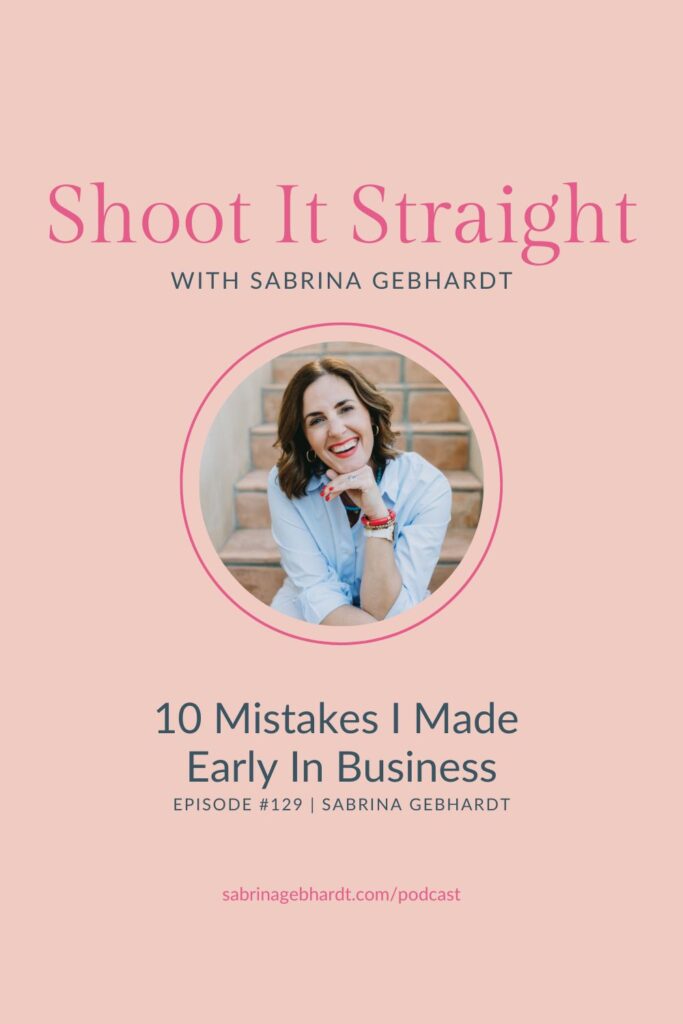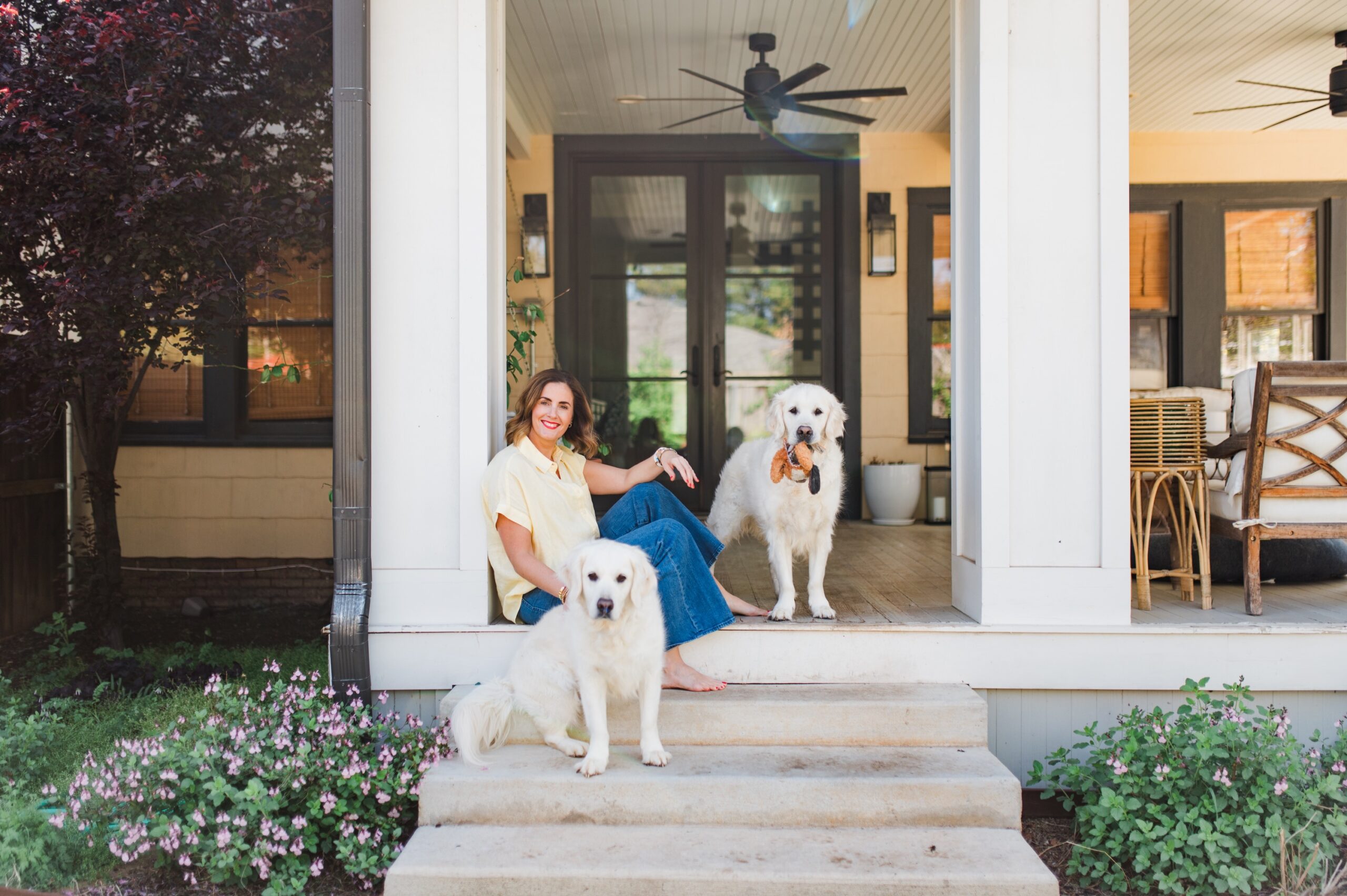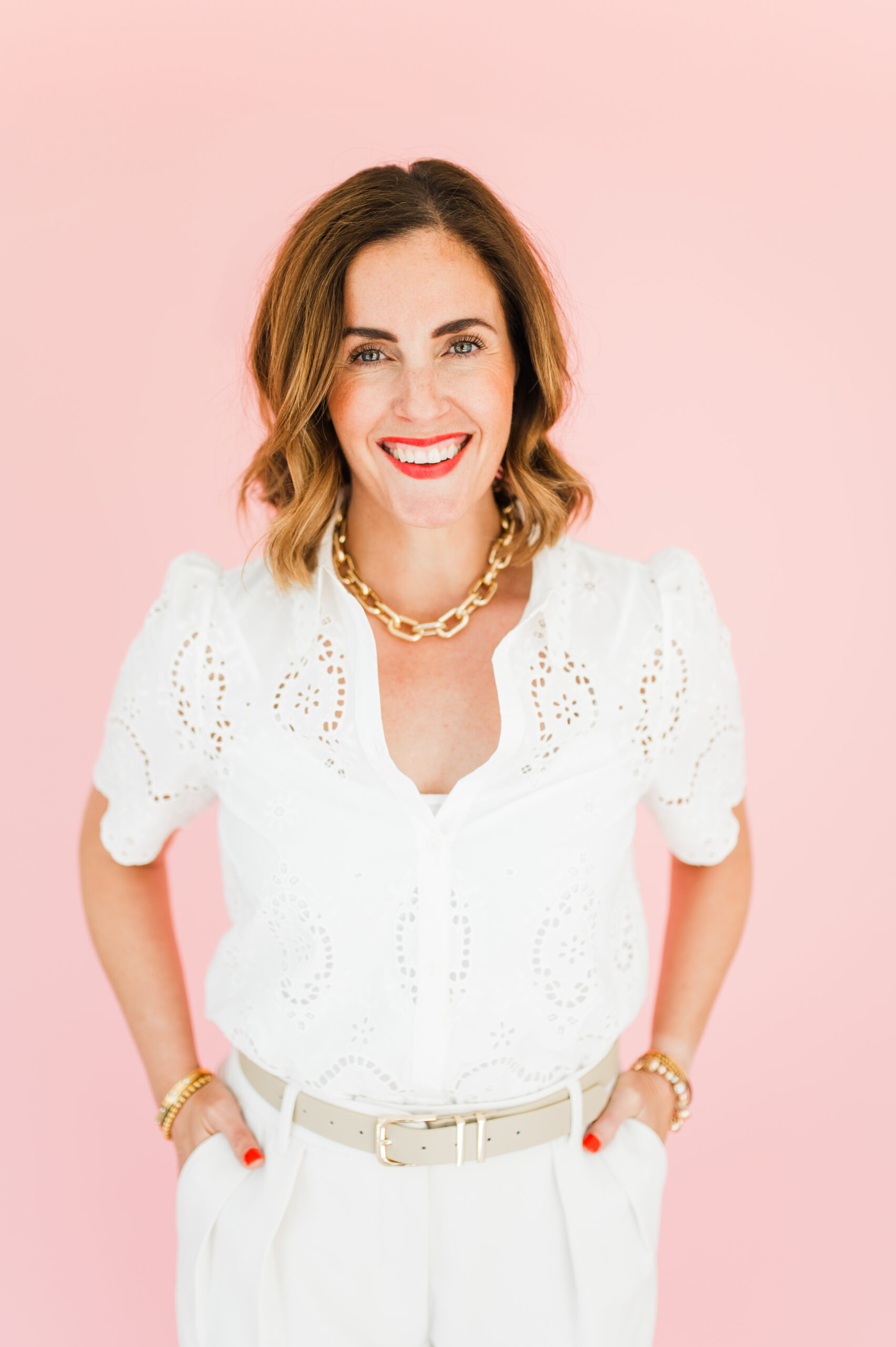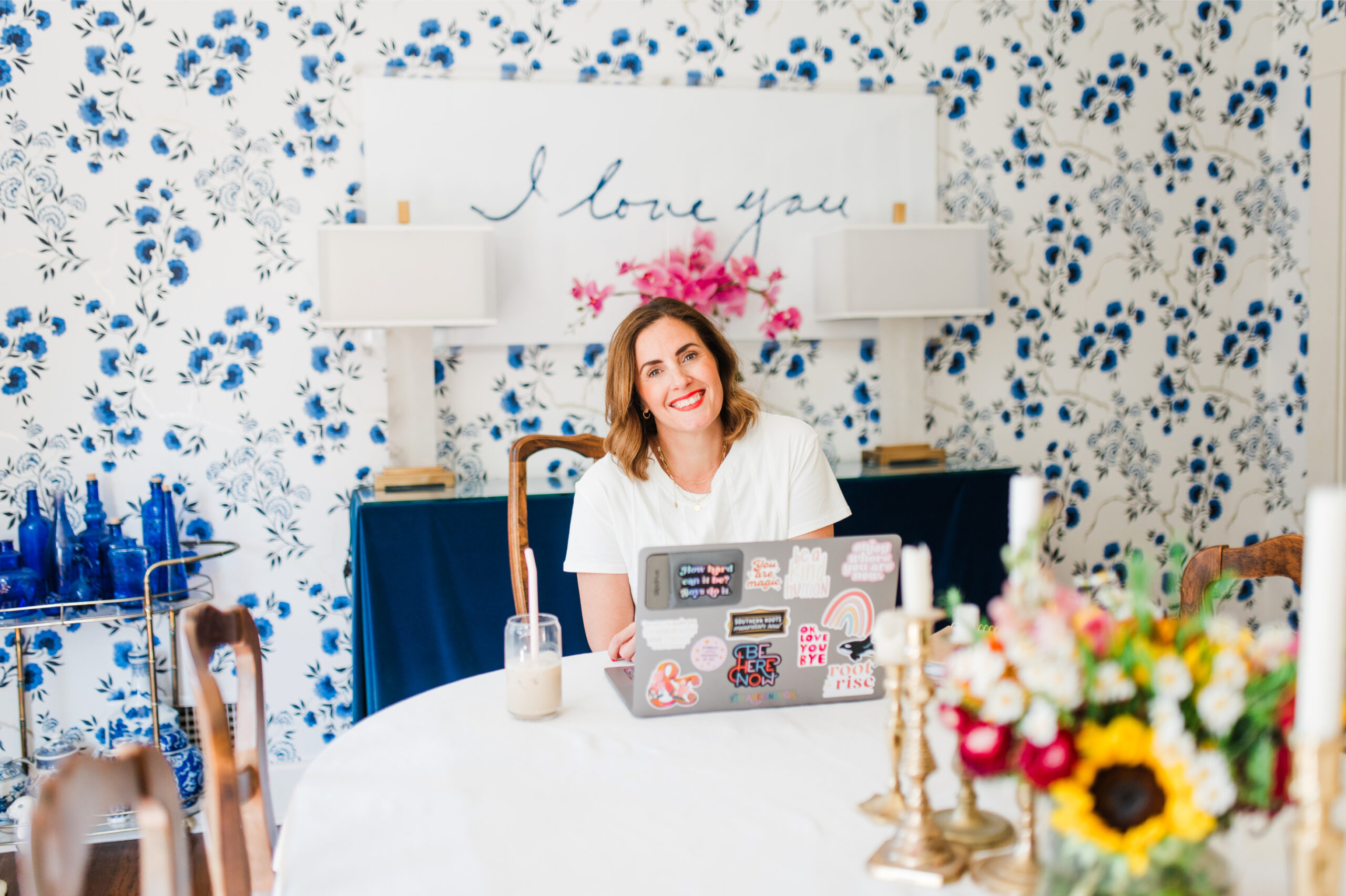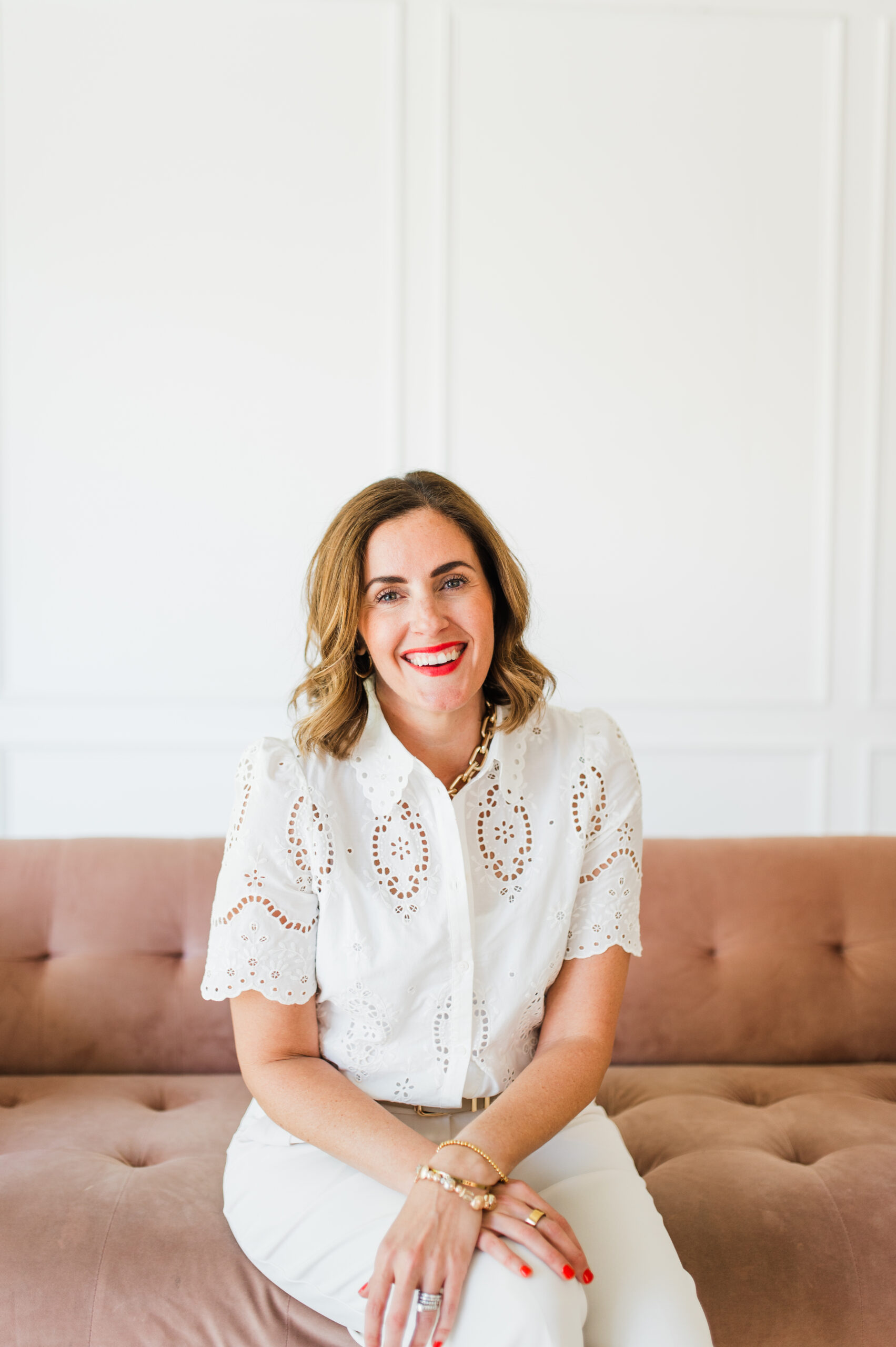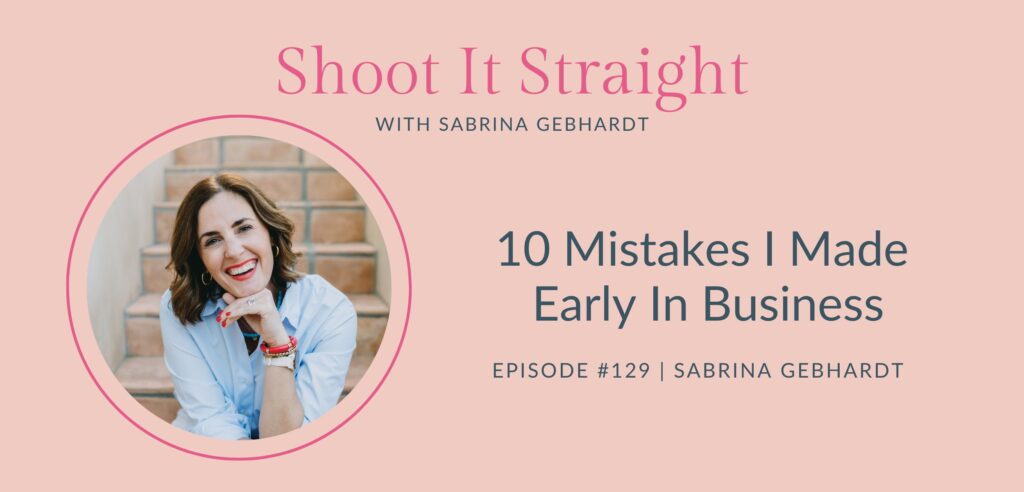
Are you making foundational mistakes in your business? In today’s episode, I’m sharing ten mistakes that I made in the first two years of my business. I had to learn these lessons the hard way, but I’m hoping that by sharing I will help you avoid them in your own business.
The Shoot It Straight Podcast is brought to you by Sabrina Gebhardt, photographer and educator. Join us each week as we discuss what it’s like to be a female creative entrepreneur while balancing entrepreneurship and motherhood. If you’re trying to find balance in this exciting place you’re in, yet willing to talk about the hard stuff too, Shoot It Straight Podcast is here to share practical and tangible takeaways to help you shoot it straight.
Subscribe on Your Favorite Podcast Player
Apple Podcast App | Spotify | Amazon
Review the Transcript
[00:00:00] Welcome to the shoot it straight podcast. I’m your host, Sabrina Gebhardt. Here, I will share an honest take on what it’s like to be a female creative entrepreneur while balancing business, motherhood, and life. Myself, along with my guests, will get vulnerable through honest conversations and relatable stories because we’re willing to go there.
[00:00:22] If you’re trying to find balance in this exciting place you’re in, yet willing to talk about the hard stuff too. The shoot it straight podcast is here to share practical and tangible takeaways to help you shoot it straight.
[00:00:38] Welcome back to the shoot it straight podcast. My friends. I’m so glad you’re here today and I’ve got something fun that I want to share about. So it is currently February. That means I am starting the second month of our current route to rise mastermind. And I’m coaching an incredible group of women.
[00:00:57] And at the start of the program, every single time, it never fails that some of the things that come up in conversations with these women feel fairly elementary. And I’m okay with that. I totally support and understand that we have to get the basics covered and squared away and buttoned up before we can get to the advanced things, right?
[00:01:22] That is the way that it should go, but it’s funny because every year I have a mix of new photographers and also very, very advanced photographers. I have people who’ve been in business a year and people who’ve been in business for 15 plus years. It’s always that way. It’s such a magical mix of women in this program and I really, really love it.
[00:01:45] But it never ceases to amaze me that even the most advanced photographers who have been in business for so long still have some fairly basic elementary questions that they want to make sure they’re doing right, so to speak, or see if there’s a way that they could do these basic, simple things better.
[00:02:04] Or maybe they’ve always done it this way. And so they assume it’s the only way to do things. And anyways, so the first month of the program, we really do start with just kind of getting everything nailed down, making sure that our business, the foundations are there. And it’s not quite what I teach in the first month of the program.
[00:02:24] That’s just what comes up in Voxer and in the coaching calls with questions. And people just want to make sure that, you know, the basics, the foundation is there before we jump ahead to all the advanced, really exciting things. But what this brings up for me. Was this idea for a podcast episode, and I’m going to share with you today 10 mistakes that I made in the first two years of my business.
[00:02:49] And the reason this idea came to me was it’s these foundational mistakes. It’s these things that I didn’t know what I didn’t know and I was trying to figure out stuff on my own. And so there’s, this is just the way that I did them, but they’re actually things that I should have, could have done differently.
[00:03:07] That would have changed the early years of my business, which could potentially have changed where I am today or what my business felt like in the messy middle. So I’ve got 10 mistakes that I made in the first two years. If you have listened to the podcast for any. amount of time. You have probably heard me say that I have.
[00:03:26] I feel like I’ve made every mistake and that’s true. But these first two years, uh, were particularly hard. They, they really were. It doesn’t mean that I was you know, unhappy or didn’t have quote unquote a successful business that I wasn’t thriving. I was in love with my business. I was obsessed with my business.
[00:03:48] I still had that like passion and that flame. And so that kind of overshadowed some of the pain and trouble that these mistakes made. But anyways, I’m going to dive in. I’m kind of rambling for this intro. I’m going to dive in. I’m going to share these 10 mistakes and I hope that it’s enlightened you. I hope that maybe it makes you feel like you’re, you’re seen if you’ve made these mistakes before.
[00:04:14] And if you are newer in business, I hope that it inspires you to look at these 10 things and not make the same mistakes that I did. First mistake I made was starting my business too soon. I started my business. way before I should have. I mean, it is shocking, really. And here’s the thing. The landscape of being a photographer was very different 14 years ago.
[00:04:42] Very, very different. It was not oversaturated. It was really super easy to just like throw out a Facebook post and all of a sudden you’re slammed. It was not hard to market your business because the saturation on social media was not there. It was totally different. And I started way too soon before I had, I just really shouldn’t have been in business.
[00:05:08] I probably should have waited a whole nother year and fine tuned a lot of things. But I dove straight in to the deep end and then figured out how to swim. And it’s funny because as, as much as I talk on the podcast and with my coaching students about thinking through and making intentional steps and making intentional plans in your business, it was literally the polar opposite back then.
[00:05:36] I was like, Oh, I have a great camera. I love to take photos. I love to take photos of my friends kids. I’m having fun dinking around in Photoshop. I should probably start a business. That’s I’m, I’m literally not joking. That’s about how it went. Because I did that, I opened up a whole can of worms with problems.
[00:05:55] I didn’t know anything about pricing. I didn’t know anything about scheduling. I didn’t know anything about websites. I didn’t know anything about client relationships. I didn’t know anything about anything. And I was by diving into business so early, I was not only having to manage a business, but also figure out how to do all the things correctly at the same time.
[00:06:17] And that’s really not what I advise. Okay, so that was mistake number one. Mistake number two is that I did not run any numbers and I charged way too little, like way too little. Okay, hear me when I say this. This is not an exaggeration. I have shared this on social media. I think I’ve shared it in a real, you could probably go find it, but I have like visual proof of this.
[00:06:44] So when I’m saying, when I’m telling you what I’m about to say, this is not an exaggeration. Mini sessions that I ever hosted were spring mini sessions. I started my business in a January. So this was like a couple months into being in business. I decided to offer spring mini sessions at some, you know, gardens in our area.
[00:07:03] Are you ready for this? I charged 35, 35 for many sessions. So it was just ridiculous. Okay. I was literally just making stuff up. And I will say that the expenses of my business, there really weren’t any back then. Okay. I had a free website. I was using free or dirt cheap software to edit. I did not have a CRM.
[00:07:31] I did not have any outsourcing or support. So I was literally like bringing in cash and not having any expenses, right? I didn’t have props. I didn’t have supplies. I didn’t have a studio. But still, regardless of the fact that I had basically no expenses to my business. When you broke down the amount of hours I was spending with each client, not only just at the session, but like mentally preparing for the session and emailing them and going back and forth to book time slots and dates.
[00:08:02] Cause I did everything manually back then and then editing, which took me absolutely forever because I had no idea what I was doing. I was making pennies. I was like a sweatshop labor. It was completely and utterly ridiculous. Also, back then I had a ton of money mindset issues, a ton, absolutely a ton. And in my mind, 35 per mini session client was freaking incredible because I got to spend an afternoon having fun photographing kids, having a break from my own family, playing with my camera.
[00:08:42] And then I got to have fun dinking around in Photoshop. And people were paying me like it felt so abundant, but looking back on it, like, what was I thinking? Absolutely. What was I thinking? That all came to a head years later, obviously I raised my prices little by little and kind of crept up. You know, my first mini sessions were 35.
[00:09:04] My next mini sessions were 50. At some point I finally hit a hundred and then I just slowly crept up and I did eventually learned the lesson that like. You have to know what your numbers are. You have to know what, what hourly rate you want to make. You have to know what kind of income you need to provide for your family.
[00:09:20] Uh, there were so many things and obviously eventually I figured out the pricing situation, but that was mistake. Number two was not running any numbers, not doing any math and just completely making up my pricing and charging way too little. The third mistake I made was people pleasing. It’s good to try everything at first.
[00:09:42] Okay. I am not going to lie unless you just happen to know right out of the gate that you are super passionate about families or weddings or brands or babies or whatever. Generally speaking, it’s good to try everything because you never know where it’s going to lead. And when you are new and you are learning the technical posing lighting skills of being a photographer, it does push your skill.
[00:10:07] It does make you better. So I’m not saying that that’s a bad thing, but pretty soon after you’re kind of dabbling in all the things, you’re going to figure out what you love and what you don’t love. And it is so important that as soon as you know what you want to be doing and focusing on in your business, that you go all in for that.
[00:10:29] I did not do that. I did not do that for fear of disappointment. I was so terrified to let people down. I was so terrified to send them somewhere else to someone who did do that thing. I was so afraid that if I sent people away, they would never come back or that I would never have a new client to replace that potential income.
[00:10:51] It was just all fear. It was all fear and just ridiculous, but I was so hardcore in the people pleasing and I was craving that validation of people wanting me. that I just said yes to everything. I said yes to absolutely everything. And that leads me straight into mistake number four, which was not setting boundaries.
[00:11:12] I did so many favors in the beginning and I honored so many random, random requests. And for the most part, every single situation was miserable. Like I’m cringing inside. I’m hating the moment. Why was I not brave enough to say no, why was I not brave enough to stand up and say, this is what I do and this is what I don’t do, or this is how this is going to go, or no, I actually don’t think that position is going to work, or no, we shouldn’t lay your newborn baby, whatever, next to this prop, which if you’ve been to one of my retreats, you’ve probably heard that story, but I did not set a single boundary with clients that really does intertwine with the people pleasing.
[00:11:56] But here’s what I tell my students, and I’m not going to dive super deep into this today because this could be an entire podcast. It’s an entire, I coach an entire module in the mastermind on this. Okay. When you do not have boundaries with your clients, when you are not willing to stand up and speak up and lay out and communicate expectations about how things will go, what to expect, what comes next, all of those things.
[00:12:23] You’re actually hurting the relationship. You will be seen and respected as more of a professional when you put those boundaries and expectations and communications out there. The more you do that, the more your clients are able to trust you to trust that you’ve got it, that you know what you’re doing, that they’re going to have a fantastic result.
[00:12:50] And they’re able to sit back and relax and not feel the need to jump in with random requests and suggestions and all of that. If you struggle with setting boundaries and people pleasing with your clients and saying, no, I want you to think about that part of it. You are actually looking like less of a professional.
[00:13:08] It’s actually harming the way that you are seen. It’s so much better to stand up and be brave, set those boundaries, have that communication and have your clients trust you. Okay. I promise it goes so much better. Mistake number five that I made in the first two years of business is waiting to invest in a CRM primarily because it costs money.
[00:13:31] So I mentioned a little while ago I had a lot of money mindset issues. I basically didn’t want to invest in anything. I wanted there to be no expenses, no overhead in my business, and that’s okay for a while. That’s okay when you’re just starting out. But like I alluded to in the beginning, when I raised my hand and decided that I was going to be in business, I was flooded with clients because it really was that easy back then.
[00:13:58] And also my peers and friends from, you know, the preschool and the Bible study and church and our neighbors and all of that, all of those peers. We’re in the target market, so to speak, of who I wanted to serve. And so all it took was me sharing something on Facebook and sending a blind copy email. And all of a sudden I was flooded with clients.
[00:14:24] I was selling out many session days. I was booking day after day after day after day after day. Yeah. Part of it was because they wanted to support me. And part of it was because I was charging nothing. But I was busy right out of the gate, which is a huge blessing. But you can imagine that When you are that busy running your business off of a spreadsheet or a notebook only last and is successful for just a very short window.
[00:14:56] At a certain point, you need to invest in a CRM to organize everything, to invoice better, to just have everything in one place. And I waited so long because of the expense. Because I didn’t want that overhead because I was charging absolutely nothing per session. And the cost of a CRM was basically the same price.
[00:15:19] And I’m like, I, that seems really expensive because my, again, my money mindset was so warped when I finally did decide to invest in a CRM. I chose the cheapest one and I chose it based on price because again, money mindset issues. It was a terrible choice. And getting my client roster moved into that CRM was a nightmare because there was such a backlog of clients and it was just a mess.
[00:15:48] It was an absolute mess. And here’s the thing, within a year I had to move to another platform because I knew almost immediately that I’d made the wrong choice. But I fumbled through getting everybody moved over anyways, hoping it would work out and end up being okay. And it wasn’t. And then I had to move again.
[00:16:06] I recommend everyone investing in a CRM almost immediately. Truly. Like you’ve got five clients. Great. It’s time to have a CRM. It is so much easier to move five clients into your CRM and to set it up clean and fresh and empty than it is to move over two years worth of clients, which is what I did. Don’t be like me.
[00:16:25] Okay, invest in a CRM. It is part of the cost of doing business. It is what it is. Get over it. You need one friend. I want to take a quick second to tell you about a new freebie I have that I’m super excited about. Whether you are hoping to launch a new offer this year, or maybe you’re just burned out and looking for some creative inspiration, you will love this new freebie portfolio on purpose.
[00:16:50] This is my exact step by step framework for planning and executing a successful model call that I’ve been teaching my paying students for years. In case you don’t know why this is so important, model calls are a great way to do a lot of really positive things in your business. They get fresh eyes on your business.
[00:17:09] They give you a way to create images that support a new offer that you might want to launch. Model calls give you a place to play and create without the expectations of paying clients. And they’re a great way to fine tune your skills and expand your portfolio. The portfolio on purpose freebie includes a video worksheets, checklists, examples, and everything you need to make this process super easy and super successful for you.
[00:17:35] When you go through portfolio on purpose, you will walk away with the knowledge of what the benefits of model calls are, how they can support your business creativity and growth, how to create one that pulls in the right people, how to keep it organized, including a step by step workflow. At the end of this freebie, you will feel inspired to take action and have the steps and tools necessary to successfully put the model call out, find the right models, and most importantly, get the images you are looking for.
[00:18:05] If you’re hoping to run a model call or maybe a few this year, head over to Sabrina Gebhardt. com backslash model dash freebie to get yours today. Okay. Back to the show. So mistake number six in the first two years of business was trying to edit like what was popular instead of what I liked. I’m sure that you, the listener have made that mistake.
[00:18:30] I think everybody has, I feel like it’s kind of a rite of passage. But man, I did it and I fell into that hole real hard because what was popular was constantly changing. Light room was very new on the scene at this point. And it made editing so much easier for people. And so people were playing around with crazy presets and doing all these wild things.
[00:18:54] Okay. The editing of the early years of my business, I just, I can barely even look at it. It makes me like physically cringe. It’s so bad. But every, like, let’s say every four or five months, it was changing. There was nothing cohesive about my editing style because I was constantly seeing what was happening around me.
[00:19:13] And I’m like, Oh, I like that. I’m going to play with doing that on this session. And then the next session I would edit completely differently. It was wild. It was wild. It is literally a miracle that any of those clients. From the early days are still with me. It’s truly, truly a miracle what they put up with back then.
[00:19:31] I think it is super, super important to have a very cohesive style from the get go. By the time you raise your hand and say, I’m in business, you should have a cohesive body of work. Clients should know what to expect. They should know what they’re going to get editing style wise. You should not ever be, you know, questioning, Oh, well, this session, maybe I should edit it this way.
[00:19:56] And maybe I should try this thing. No, no, no, no. You need to figure that out before you start charging. Do not look like a fool like me and be willy nilly with your editing style all over the place. Cohesiveness matters. It matters really, really big. It’s massive. Okay. So nail down your editing style. Stop paying so much attention to what is quote unquote popular.
[00:20:21] If you are seeing light and airy images all over the internet and that’s not your jam. Cool. Do something different. It’s going to help you stand out. Or if you’re surrounded in your area by people who do, you know, really dark and moody and really warm images, but that’s not your jam. Cool. Do something different.
[00:20:40] Be willing to nail down the editing style that speaks to you and that you want to represent your body of work. Similar to that, mistake number seven that I made was looking around competitors for inspiration. Instead of looking at everything else there is to look at. I wasn’t looking around at nature or people or art or movies or relationships.
[00:21:07] I wasn’t paying attention to the world, so to speak. And letting that inspire the way that I photographed clients and the way that I edit. I was just paying attention to my competitors. What’s everybody else doing? What poses are they doing? What does it look like is happening at their session? What’s their editing style?
[00:21:28] What are they sharing about for their pricing and what’s included and all of that? What locations are people using? I just, I was trying so hard to emulate what was happening around me instead of being willing to just be an artist and be inspired by everything else in the world. And it really kept me.
[00:21:47] Stuck in imposter syndrome and doubt for way too long because when all you’re doing is looking at competitors, you’re going to stay stuck in imposter syndrome because your work is never going to look like somebody else’s. It’s not. And if you’ve never heard somebody say that, I’m telling you that right now.
[00:22:05] Your work is never going to look like somebody else’s because somebody else took that photo. Somebody else was in that moment. It’s somebody else’s creative eye. You can create the work that you can create to stop looking around for inspiration and just shoot from your own creative eye, edit from your own creative eye.
[00:22:26] Let the world around you inspire you. So if you’ve ever dealt with imposter syndrome, that’s one of the best ways to do it is to stop looking around at your competition. And just start looking around the world and be willing to stand firm in the way that you see moments happen and capturing them.
[00:22:43] Mistake number eight was that I made quick and rash decisions all the time. Listen, I am all for making swift moves when you are, when you have that intuitive hit, when your gut is pulling you in a direction. I’m all for that. I think that we are rewarded by swiftly following our gut and our intuition. I really, really do.
[00:23:10] But it’s another thing entirely when you’re like super wishy washy and constantly changing directions. Those first few years in my business. Everything was constantly changing and I, I truly mean everything. My editing was constantly changing. My prices were constantly changing. I was constantly redesigning my website because I thought that it wasn’t good enough.
[00:23:38] And when I say redesigning my website, I mean literally like starting over. I can’t tell you how many websites I had in the first two years. It’s quite ridiculous. And every time I did that, I was also tinkering with like what my logo looked like, which is again, ridiculous. My social media, my CRM, everything was constantly shifting.
[00:23:58] I would see something cuter, better or different. And instead of stopping to think about if I actually needed or wanted that thing, I just went for it. I was stuck in the worst comparison imposter syndrome. What they have is what I need. If I want to be as successful as that photographer over there, I must do things their way.
[00:24:21] And I was just so all over the place. You know, we talk about the distractions and like squirrel, uh, that was literally the first two years of my business. There was, there was never time for the dust to even settle truly. And looking back, I really do think that the only reason that I continue to stay busy and I continue to have referrals and I continue to have clients come back is because of me.
[00:24:46] It’s because of me. They connected with me. I’m sure they were happy enough with their images. You know, the pricing was super cheap that whole time. I’m sure that it had nothing to do with My website, my CRM, my social media, my logo, any of that, right? And I wish that I would have been more intentional about all those things from the get go.
[00:25:11] Again, I look back and I think, gosh, if I would have just decided I was going to become a photographer and then given it a year to like fine tune all the things before I officially went into business. It would have been so different. I would have had a cohesive body of work and beautiful editing style, potentially a CRM and uh, an intentional website and intentional logo and a social media plan.
[00:25:41] And I would have been confident in my pricing. I mean, it just would have been so much easier and less chaotic, but that’s not the way I did it. That’s not the way that it went the first two years. And I made things so much harder than I needed them to be. I was slammed with clients and slammed with editing, which again was taking me, you know, way too long because I was terrible at it.
[00:26:03] But then in every waking moment, I was filling in these projects that I didn’t need to be doing. Oh, time to redesign my website again. Oh, I found a better logo that I’m going to, you know, purchase and do. Oh, I’m going to have to change to a different CRM. Oh, I’m going to try this different social media thing.
[00:26:17] I mean, I was constantly reinventing the wheel and it was ridiculous. So that was another mistake that I made. Mistake number nine. And this is a big one was not prioritizing myself. My first two years of business. I was also in the parenting trenches. I had a four year old and a one year old, and I’m sure it was because like I said earlier of that excitement and that passion, but I gave every waking second to my business, whether it was emails or photographing sessions or editing or making all those changes that I just talked about.
[00:26:53] There was no such thing as session capacity. There was no such thing as turning people away. There was definitely no white space. I was photographing everyone and everything anytime I had child care. Period. End of story. I was giving everything to my business. And you can imagine where that landed me. I was not in a good spot at that two year mark.
[00:27:19] It kind of all just hit me that I was extremely overwhelmed, extremely overworked, didn’t have enough in my bank account to show for how hard I was hustling. At that point, I made a really big decision and this brings me to mistake number 10. You probably know what I’m about to say here, but mistake number 10 in the first two years of business is not investing in education.
[00:27:48] I insisted on figuring it out all on my own and doing everything the hard way for the sake of saving a buck. That is probably the biggest mistake I made. So around the two year mark is when I realized. If I’m going to do this and if I’m going to go all in and if I’m going to really make money and be this great photographer in our area, which I had visions of being, I needed help because I obviously what I was doing wasn’t working.
[00:28:19] It was time. To invest in education. It was time to get support from people who had gone before me. It was time to join a program, go to a conference, work with a mentor like I kept seeing online. I was done with thinking I can’t invest in that. I am not worth that amount. It’s too scary to pay that price to join that program.
[00:28:44] I was done. Had a talk with my husband. He agreed we were gonna go for it. And that’s the year that I went from never investing in education. I did three huge education things in one year. And if I would have just done those sooner, I could have skipped almost all of the other mistakes that I had made. If I had invested in education sooner, I literally would have priced myself better, had better editing, had more confidence to niche down, known that I needed a CRM, made more intentional decisions.
[00:29:16] I mean, every other mistake would have been skipped. But I had been so terrified of investing that kind of money and I didn’t believe in myself, didn’t trust myself that I would earn that money back and that it was a, that it was an investment in my future that I waited and I put it off and I wouldn’t allow myself to do it.
[00:29:37] But you’ve probably heard me share on the podcast before that third year when I made those three investments, I attended a weekend retreat. I attended my first conference. And I attended a one day workshop with a mentor that I adored. I did three things in one year. And after that, I never looked back. My business never looked the same again in the best possible way.
[00:30:03] Everything changed. Everything changed. I make my investment back from those things almost instantly with the things I learned. The confidence I gained, the money that I made from doubling my prices instantly, and then doubling them again within a year. niching down, having beautiful editing, turning people away, having a session capacity, getting organized.
[00:30:29] I mean, just all of it. I can go on and on and on about how life changing that year was. And I just kicked myself for not doing it sooner. So those are the 10 mistakes that I made in the first two years of my business. And like I said at the beginning, I hope that this inspires you. I hope you resonate with the stories I share.
[00:30:48] Maybe you’re making some of these mistakes too. And I hope that this has encouraged you to move forward, to move past them. And to trust yourself, there’s room for you in this industry. Even if your business feels hard, there’s room for everyone. That’s all I’ve got for you on the podcast today. So we’ll see you next week.
[00:31:09] Thanks so much for listening to the shoot it straight podcast. You can find all the full show notes and details from today’s episode at. Sabrina Gebhardt dot com backslash podcast. Come find me and connect over on the gram at Sabrina Gebhardt photography. If you’re loving the podcast, I’d be honored if you hit that subscribe button and leave me a review until next time, my friends shoot it straight.
Connect with Sabrina
Instagram | Facebook | Pinterest
This episode is brought to you by Portfolio On Purpose, my step-by-step framework for planning and executing a successful model call. Model calls are so important for getting fresh eyes on your business, to create fresh images for new offers, and to create without the expectations of paying clients. With Portfolio On Purpose, you will feel inspired to take action and will have the steps and tools necessary to run a successful model call and get the images that your business truly needs.
Review the Show Notes:
Starting my business too soon (4:22)
Not running any numbers (6:23)
People-pleasing (9:36)
Not setting boundaries (11:06)
Waiting to invest in a CRM (13:23)
Editing based on what was popular (18:18)
Looking to competitors for inspiration (20:48)
Making only quick, rash decisions (22:43)
Not prioritizing myself (26:24)
Not investing in education (27:33)
Connect with Sabrina:
Portfolio On Purpose: sabrinagebhardt.krtra.com
Root To Rise Mastermind: sabrinagebhardt.com/mastermind-waitlist
Instagram: instagram.com/sabrinagebhardtphotography
Website: sabrinagebhardt.com
